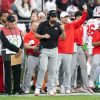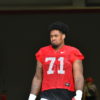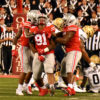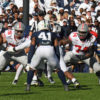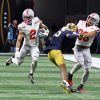
K.J. Hill is just about the most prototypical slot receiver you’re ever going to see. He’s 6-foot, flat, and checks in just under 200 pounds. He has big hands relative to his size, but leaves something to be desired athletically, running a 4.6 40-time that doesn’t quite a match up with the new expectation of slot receivers with the rise of players like Tyreek Hill. He catches everything thrown his way, runs good routes, and doesn’t make any mistakes.
That’s how all slot receivers used to be. It wasn’t a position for the fastest or for the quickest, rather, it was usually filled by smaller technicians that could be relied on to catch everything, even if it meant absorbing a hit from a safety going across the middle. The old prototype used to be players like Wes Welker, who would catch 100 passes without topping 1000 yards.
As offenses have moved into the spread mold, the need for players like that has fallen, because receivers are being schemed for open, and quarterbacks are better at reading defenses than they were even just 10 years ago. The need for tough catches has dropped, because there are fewer tough catches to be made.
The new model looks a lot like Hill, JuJu Smith-Schuster. There’s still room for excellent route runners, like Keenan Allen, but for the most part, that style of player just doesn’t exist as much anymore. Bigger, faster wide receivers have cut into the route running gap enough that having a 6-4 outside receiver that can run routes pretty well is more valuable than a 5-11 slot receiver that makes his living on hard cuts and possession. Without a need for it, modern offenses aren’t producing as many slot receivers, which means that fewer players are entering the NFL with that skillset.
That makes Hill an anomaly of sorts. He isn’t just a true slot receiver, but he’s a true slot receiver that came from an offense on the cutting edge of innovation. He didn’t play in an offense led by coaches that still want it to be 2007, he played under one of the most forward-thinking offensive coaches in the country, in an offense defined by its ability to scheme open receivers regardless of route running ability. Hill managed to carve out a role for himself in an offense that explicitly does not require a player with his skillset to function.
Because of that, it feels pretty safe to think that there’s no good reason he couldn’t do it again at the next level, which, for all the steps in the right direction it has taken offensively, is still behind some of the most innovative schools in America, including the one that Hill played for in college.
A lot of that comes down to what exactly made Hill so great in college, which is to say that he essentially filled the role that receiving tight ends usually fill: he was a safety blanket for Justin Fields.
That’s largely due to his route running ability and sure hands, because Hill was usually open, and he almost always caught the ball when Fields targeted him. Here, he shakes the safety easily and gets into Fields’ line of vision across the middle as quickly as he can. He’s turning his head to the quarterback as he’s coming out of the cut to make himself available for a pass, and he does a great job of keeping his body between the ball and any potential defenders behind him.
Getting into open space like this and creating an open throw for your quarterback is a skill, and a skill that Hill has essentially mastered. It works better against zone than it does man, but as Hill shows here, it can be valuable against man coverage as well if done correctly.
As he shows here, this is really dangerous against zone, something he won’t see a ton of at the next level, but will see enough of to take advantage of a couple times a game. Michigan State drops into a three-deep shell, with four defenders underneath, meaning that the gaps in the defense are going to be right behind the linebackers, but under the three-deep backs. Hill is running a dig route, reads the zone, and looks to find space in that soft spot behind the four-shell underneath. With the play breaking down, Hill’s ability to find that space leaves him wide open, and gives Fields an easy throw, even with pressure bearing down.
FIT
Now, Hill obviously has his flaws, as every player does, which is why he isn’t projected to be drafted until the later rounds. His physical limitations are the most significant and obvious. Because of his lack of size or elite athletic ability, Hill is essentially only going to be able to continue in the role that he filled at Ohio State. His value is as a target underneath, someone who can get open and pick up first downs consistently. He isn’t a big play threat, nor is he going to make defenders miss after the catch on a regular basis.
That means that his fit will need to be with a team that understands how to use a player of his style, allowing him to do his work underneath in the slot without asking him to make much happen downfield or in the horizontal passing game (which Ohio State tried with bubble screens and quickly abandoned).
He’s also going to need a quarterback capable of improvising, because a lot of his best work is done when the play breaks down. Someone like Patrick Mahomes obviously comes to mind there, but Kyler Murray, Baker Mayfield, and even someone like Joe Burrow come to mind, along with quite a few of the other younger quarterbacks in the league. Hill isn’t going to make a ton of sense with someone like Joe Flacco.
All told, Hill is a bit of a luxury pick, but a pick that would make sense for a team looking to make its young quarterback more comfortable, or provide one more weapon in a push for a super bowl run sooner than later. Hill is an immediate impact guy that seems to have already hit his ceiling, and whoever drafts him is essentially getting what they saw from him on film. That has plenty of value on a lot of clubs, but this isn’t the pick for a team hovering around 8-8 with a middling quarterback.



